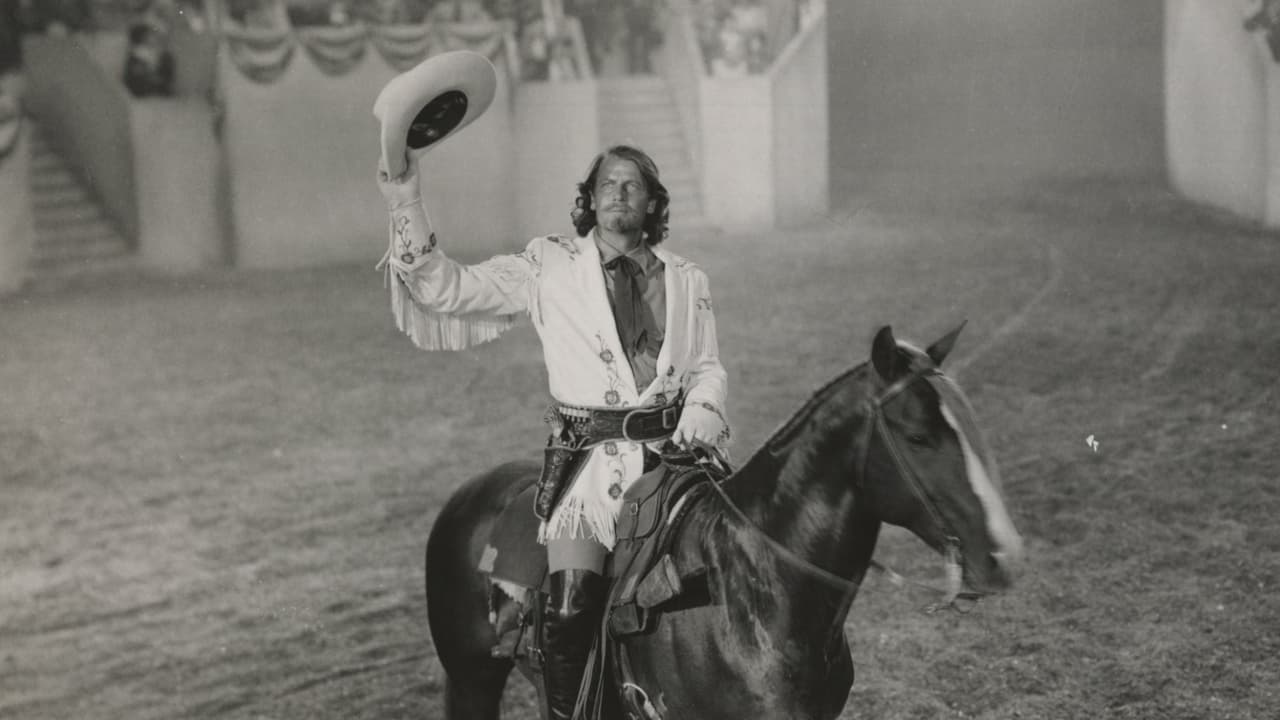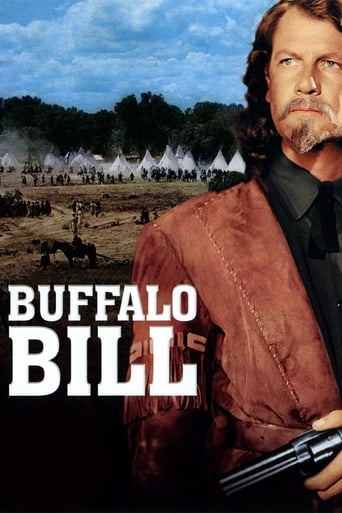

A mix of reasonably accurate historical details relating to Bill Cody, and pure fiction. He did have a long suffering wife named Louisa, whose often rocky marriage is pictured as better than it actually was. Of course, Maurine O'Hara makes a lovely wife for him. Joel McCrea makes an OK, but not spectacular, Bill. Thomas Mitchell plays the newspaper and dime novel story teller: Ned Buntline: another genuine historical person. Ned is also correctly portrayed as the instigator of the idea of Bill heading a traveling wild west show. Anthony Quinn plays the Cheyenne chief Yellow Hand(incorrectly translated. Should have been Yellow Hair), who interacts with Bill periodically until he is killed by Bill in a grapple in a river, in front of a large number of troupers and braves. Historically, this was known as the Battle of Warbonnet Creek, herein called Warbonnet Gorge. In the film, this is followed by an exciting hand-to-hand battle between the 2 cavalries, largely taking place in a wide shallow river. Historically, this 'battle' didn't happen. After Yellow Hand's death, the Cheyenne dispersed back toward their camp, in view of the large number of cavalry they saw. Historically, Bill killed Yellow Hand with a bullet , not a drowning, and scalped him, shouting "First scalp for Custer", in relation to the recent extermination of Custer's cavalry company.Like many of the other scouts for the armies in the Indian Wars, Bill Cody had an ambiguous relationship with the Native Americans, scouting for the army in pursuing them, and slaughtering the bison they depended on for practically everything. Yet, he was interested in their cultures and often friendly with them, including them in his wild west shows. Whether true or not, in his speech an a banquet honoring him with the Congressional Metal of Honor, he blasted the "the only good Indian is a dead Indian" mentality of too many, suggesting that the only Indian they cared about was the Indian on their pennies.Thus, this film provides a rare, for the times, sympathetic treatment of Native Americans, some years before the overrated, in this respect, "Broken Arrow". It's also a rare, for it's times, Technicolor western.Thomas Mitchell, as Ned Buntline, imparts occasional humor, as does Edgar Buchanan, as an old army sergeant, who gets his walking papers and vanishes. Beautiful Linda Darnell has a strange ill-defined peripheral role as a Cheyenne maiden, who is sometimes the school teacher, but rides off to join the warriors at Warbonnet gorge, where she is killed during the ferocious battle. Bill carries her body, and someone asks if she was a friend "They were all my friends" Bill laments.A particularly clever bit of writing went into the marriage proposal by Bill to Louisa. They are in a shed next to the stable for Bill's horse. The horse rubs its head on Louisa's shoulder and gives her a 'kiss'. Louisa asks about a blanket on the wall. Bill says its a Cheyenne courting blanket for maidens. He shows her how it is worn. She asks how the brave responds. If he accepts, he plays a special tune on a small flute, as Bill demonstrates. How does the maiden then respond? She opens the left side of her blanket, beckoning the brave to enter. Bill does this, and they kiss.
... View More"Buffalo Bill" (1944) is a a fictionalized biopic of the life of "Buffalo Bill" Cody (Joel McCrea) who worked as a scout for the US Army and later traveled East, establishing his Wild West show and becoming an international sensation.Director William Wellman and a writer worked for months on a script that told the true story of Buffalo Bill, including that he was a drunk, a charlatan and an unfaithful husband, but -- ultimately -- they said they couldn't destroy the legend, so they destroyed their screenplay and hired writers to write the myth.This explains people's criticism of this classic Western, but if you can accept that it's more myth than fact it's quite entertaining, especially considering the time it came out. Several things surprised me about this movie. For one, it clearly takes a pro-Indian stance and this was a full two decades before it become "hip" to do so. Secondly, the depiction of the Indians is good and they used real Natives as peripheral characters. Although Anthony Quinn plays Yellow Hand, he looks convincing, probably because he had Native blood.The Cheyenne and Sioux are portrayed in a noble manner as people protecting their way of life from the Europeans who don't keep their word and slaughter the buffalo en masse for no logical reason. There's a stunning scene when the Natives confront the cavalry and Yellow Hand stands up to Buffalo Bill. After the battle, Bill holds the body of an Indian woman he knew (Linda Darnell) and someone asks, "A friend of yours?" Bill sadly responds, "They were all my friends."Interestingly, a black boy is shown in one of the carnival scenes and even has a line, which is notable considering this was a full two decades before the Civil Rights movement. Some facts: The character of Yellow Hand was taken from the real-life Cheyenne chief Yellow Hair whom Cody shot, stabbed and scalped after Little Big Horn. As already noted, the movie is a whitewash and omits the fact that Cody sued his wife, Louisa Frederici (Maureen O'Hara), for divorce in 1905. They had four kids, but two died when they were young.Some criticize the way Bill stands at attention while prince Yellow Hand walks in half-naked wherein Bill lifts his hand and says "How." My Response: Didn't the Europeans (sometimes) talk with half-naked Natives when they met, which was fitting since it was the heat of the summer? So what's the problem with depicting this in the film? And wasn't "Howgh" an actual greeting with some tribes? It was. "Hau" was a greeting of the Lakota/Dakota Sioux, which is one of the two tribes depicted in the film; in fact, this greeting is still used by Sioux people today. Other tribes had similar words for greetings. As such, what's wrong with depicting this in the film, particularly since the actors pulled it off? Besides, at that time in the early 40s it hadn't become the stereotypical cliché that it later became.Bottom Line: Yes, there's some roll-your-eyes myth-making in "Buffalo Bill" (like the kid with crutches at the end), but the story maintains your attention and there's a lot of rollicking entertainment, especially the exciting Cavalry vs. Indians segments. Beyond that, McCrea and Quinn are great, the locations are spectacular, the women are beautiful and the Natives are presented in a respectable and believable way, particularly considering the picture was made in the early 40s.The film runs 89 minutes and was shot in Utah, Arizona and Montana.GRADE: B+ADDITIONAL COMMENTARY: "Buffalo Bill" was one of the first pro-Native Westerns, which came into vogue by the 60s/70s. This is a good thing because it's important to see the other side of the Indian Wars, but let's not whitewash history. The Black Hills were first inhabited by the Arikara tribe followed by the Cheyenne, Kiowa, Pawnee and Crow. These tribes were defeated by the Sioux, who migrated out of the Minnesota woods (actually chased out by their enemies, the Ojibwa and Chippewa). The Sioux then used their superior numbers to take the Black Hills from the other tribes that resided in the area.I point this out because Native Americans were guilty of the very thing we accuse European settlers/soldiers/prospectors of doing -- invading lands that weren't theirs. Furthermore, applying modern thinking is a dishonest tool when inspecting the relations between Native and settler/soldier/prospector. We always hear of the injustices committed by the US Army or settlers and get a handful of examples: Wounded Knee, Bear River and Sand Creek. Yet we never hear the other side of what caused these events nor do we hear of the atrocities of Natives committed against New Americans. For instance, we never hear of the Dakota "War" of 1862 (Santee Sioux went on the war path and murdered between 600-800 white settlers, which constituted the largest death toll inflicted upon American civilians by an enemy force until 9/11), The Ward Massacre, The Nez Perce uprising which killed dozens of settlers in Idaho and Wyoming, and the Massacre at Fort Mims. We never hear of the countless innocent settlers who were murdered by roaming bands of young "warriors": While a chief was signing a peace treaty on the tribe's behalf they were out robbing, raping and murdering. I'm just saying that it's easy to be pro-Native sitting on the comfort of your sofa, but not so much when you and your loved ones are threatened with slaughter.The Europeans wanted the Native's land and resources while the Indians wanted the technology of the Europeans. Both sides used treaties to make peace while still trying to get what they wanted when war was too expensive. Both sides made war when they felt no other option. I love Native American culture, but the whitewashing of Native atrocities and this revisionist history stuff is dishonest and unbalanced.
... View MoreThis biopic looks back at the life of the legendary Buffalo Bill Cody. Given the subject, the fine cast, a veteran director, and the Technicolor cinematography, the film is a disappointment. The main failing appears to be the script, which is episodic and meandering. After focusing on Bill's frontier escapades, the latter part of the film dwells on his career as a showman, and this is where the film really bogs down. McCrea is believable, if a bit bland, in the title role. O'Hara is given little to do other than look lovely, which she manages quite well. Darnell is also little used as a spirited Indian. Mitchell, Buchanan, and Quinn round out the familiar cast.
... View MoreThis film is a hidden gem in western film lore and has fine work by Joel McCrea in the title role. The movie has great color and scenery, a fine cast, a great battle scene, and genuinely poignant moments. The random slaughter of buffalo is the spark that sets off a powder keg that explodes with Indians going on the warpath to drive the white invaders from their hunting grounds. The thrilling clash of red and blue at War Bonnet Gorge is perhaps the best ever filmed by any major studio on any level. The fight symbolized the struggle of two cultures and a way of life that the Indians fought desperately to preserve. The soldiers and Indians are a blur in a savage mixture of military conflict that forever broke the resistance of the Plains Indians to westward expansion. Maureen O'Hara is pretty as Mrs. Cody and Thomas Mitchell does well in his role as Ned Buntline.
... View More